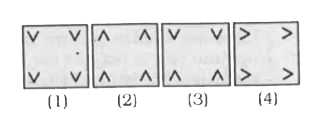List four properties of Be in which Be differs from rest of the family members.
Step-by-Step Text Solution:
1. Small Ionic Size and High Charge Density:
Beryllium (Be) has a very small ionic size compared to the other alkaline earth metals. The Be²⁺ ion is exceptionally small and has a high charge density. This property leads to a preference for covalent bonding in its compounds, unlike the other group members (like Mg, Ca, Sr, and Ba), which predominantly form ionic compounds.
2. Coordination Number:
Beryllium has a maximum coordination number of 4, which is lower than that of its group members. The other alkaline earth metals can achieve coordination numbers of 6 or more due to the availability of d-orbitals, which Beryllium lacks. This restricts Be's ability to form complex structures.
3. Amphoteric Nature of Oxides and Hydroxides:
Beryllium oxides (BeO) and hydroxides (Be(OH)₂) are amphoteric, meaning they can react with both acids and bases. In contrast, the oxides and hydroxides of other alkaline earth metals are generally basic and do not exhibit amphoteric behavior.
4. Formation of Oxide Coating:
Beryllium forms a protective oxide coating on its surface, which prevents it from reacting with acids. This property is unique to Beryllium within its group and is a reason for its diagonal relationship with aluminum. Other alkaline earth metals do not form such protective coatings.
5. Dimeric and Polymeric Forms:
Beryllium compounds, such as beryllium chloride (BeCl₂), exist in dimeric and polymeric forms. This behavior is not observed in the other alkaline earth metals, which typically form simple ionic compounds.
Summary of Properties:
- Small ionic size and high charge density leading to covalent bonding.
- Maximum coordination number of 4.
- Amphoteric nature of oxides and hydroxides.
- Formation of a protective oxide coating.
- Existence in dimeric and polymeric forms.
---
Beryllium (Be) has a very small ionic size compared to the other alkaline earth metals. The Be²⁺ ion is exceptionally small and has a high charge density. This property leads to a preference for covalent bonding in its compounds, unlike the other group members (like Mg, Ca, Sr, and Ba), which predominantly form ionic compounds.
Beryllium has a maximum coordination number of 4, which is lower than that of its group members. The other alkaline earth metals can achieve coordination numbers of 6 or more due to the availability of d-orbitals, which Beryllium lacks. This restricts Be's ability to form complex structures.
Beryllium oxides (BeO) and hydroxides (Be(OH)₂) are amphoteric, meaning they can react with both acids and bases. In contrast, the oxides and hydroxides of other alkaline earth metals are generally basic and do not exhibit amphoteric behavior.
Beryllium forms a protective oxide coating on its surface, which prevents it from reacting with acids. This property is unique to Beryllium within its group and is a reason for its diagonal relationship with aluminum. Other alkaline earth metals do not form such protective coatings.
Beryllium compounds, such as beryllium chloride (BeCl₂), exist in dimeric and polymeric forms. This behavior is not observed in the other alkaline earth metals, which typically form simple ionic compounds.
- Small ionic size and high charge density leading to covalent bonding.
- Maximum coordination number of 4.
- Amphoteric nature of oxides and hydroxides.
- Formation of a protective oxide coating.
- Existence in dimeric and polymeric forms.
Topper's Solved these Questions
- S-BLOCK ELEMENTS ( ALKALI AND ALKALINE EARTH METALS ) BOOK - MODERN PUBLICATIONCHAPTER - S-BLOCK ELEMENTS ( ALKALI AND ALKALINE EARTH METALS ) EXERCISE - Revision Exercises (Objective/Very Short answer questions( Long Answer Questions ) )
10 Videos
- S-BLOCK ELEMENTS ( ALKALI AND ALKALINE EARTH METALS ) BOOK - MODERN PUBLICATIONCHAPTER - S-BLOCK ELEMENTS ( ALKALI AND ALKALINE EARTH METALS ) EXERCISE - HIGHER ORDER THINKING SKILLS
18 Videos
- S-BLOCK ELEMENTS ( ALKALI AND ALKALINE EARTH METALS ) BOOK - MODERN PUBLICATIONCHAPTER - S-BLOCK ELEMENTS ( ALKALI AND ALKALINE EARTH METALS ) EXERCISE - Revision Exercises (Objective/Very Short answer questions(One Word/ Very Short sentence Answer ) )
25 Videos
- REDOX REACTIONS BOOK - MODERN PUBLICATIONCHAPTER - REDOX REACTIONS EXERCISE - COMPETITION FILE (Objective Questions) (C. MULTIPLE CHOICE QUESTIONS)
9 Videos
- SOME BASIC CONCEPTS OF CHEMISTRY BOOK - MODERN PUBLICATIONCHAPTER - SOME BASIC CONCEPTS OF CHEMISTRY EXERCISE - COMPETITION FILE (INTEGER TYPE AND NUMERICAL VALUE TYPE QUESTIONS)
10 Videos
Similar Questions
Knowledge Check
Point out in which of the following properties oxygen differs from the rest of the members of its family (Group-VIA)
AHigh value of ionisation energiesBOxidation states (2,4,6)CPolymorphismDFormation of hydridesMembers of the family Hominidae are:
Aman, lemur, apeBmonkey, ape, lemurCchimpanzee, lemur, apeDman, chimpanzee, gorillaOxygen differs from other member of irts family due to
Aits small atomic sizeBits high electronegativityCabsence of d-orbitalsDAll of these
List four physical properties of metals. Name two metals. Name a metal which is liquid at room temperature.
View SolutionWhich figure is different from the rest?

View SolutionIn the question given below there are four figures in question, out of which one is different from the rest. Identify the odd man out.

View SolutionThe first member of alkene family is
View SolutionThe reason why beryllium differs from rest of the members of its family (Group - by)
View Solution
